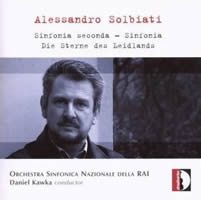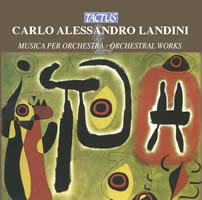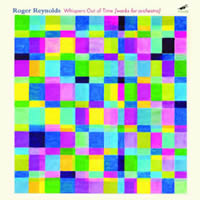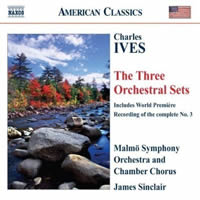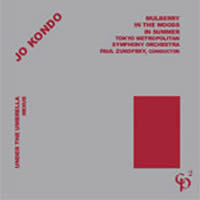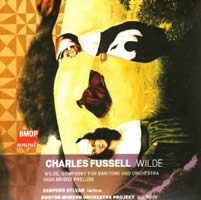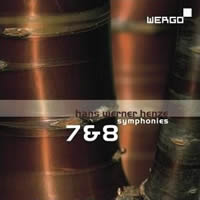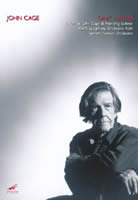Mostly Symphonies 9.
|
Grant Chu Covell [January 2009.]
Alessandro SOLBIATI: Sinfonia Seconda (2005); Sinfonia (1998-2005); Die Sterne des Liedlands (1991). Orchestra Sinfonica Nazionale della RAI, Daniel Kawka (cond.). Stradivarius STR 33760 (http://www.stradivarius.it/). Distributed in the US by Allegro Music (http://www.allegro-music.com/). Bursting like firecrackers, Solbiati’s two symphonies strike the listener as difficult works born of equally hard labor. The Sinfonia’s four tracks delineate an arbitrary range of moods, frequently progressing in concurrent layers. A scorching earnestness is broken with the second-movement Danze, which fondles antique fragments. Otherwise the insistent brashness never relents except for an Intenso slow movement, the twisting cello solo of which updates Bartókian night-music. The two-part Sinfonia Seconda moves from virulent fanfare through barrages of trills towards an unexpectedly smooth, almost post-minimalist concoction of gentle chords. The mind’s eye sees an explorer with machete hacking through thick foliage, overcome finally by malodorous exhalations. Porting less baggage, the earlier Die Sterne des Liedlands, orchestral intermezzi from a multi-part Rilke setting, unfolds more straightforwardly. Kawka and the RAI navigate these tricky works confidently.
Carlo Alessandro LANDINI: Sinfonia in La (1980); Time on Target (1999); Sinfonia in Si (2002); Midrash Temurah (2003). Orchestre Régional de Poitou-Charentes, Renaud Picard-Lalanne (cond.); MBS Symphony Orchestra, Jason Tipple (cond.); Budapest Philharmonia, János Erdélyi (cond.); Orchestra da Camera “Milano Classica,” Massimiliano Caldi (cond.). Tactus TC 951201 (http://www.tactus.it/). Distributed in the US by Allegro Music (http://www.allegro-music.com/). Contemporary orchestral music seems a detour from Tactus’ usual menu. Like the spectralists, Landini (b. 1954) will hug a particular tonality or chord, permitting twitchy percussion and solo arabesques to flit across its surface. Sometimes the effect is of an orchestra tuning up. A writer on musical aesthetics, physiology, physics and mathematics, he erects structures that also employ the golden section and various strategies designed to manipulate expectations. The results can be dreamy, as in Time on Target, or solemn, as in the two symphonies. The most magical of these pieces, Midrash Temurah, employs just 13 strings, with hints of Scelsi, Sibelius and Coates. I presume that different ensembles (each piece was recorded by a different orchestra) would produce completely different balances. As if to reassure, Tactus unnecessarily caps each work with audience applause. We should hear more Landini.
Roger REYNOLDS: Symphony[Myths] (1990); Whispers Out of Time (1988); Symphony[Vertigo] (1987). Tokyo Philharmonic Orchestra, Kotaro Sato (cond.); Cleveland Chamber Symphony, Edwin London (cond.); La Jolla Symphony Orchestra, Harvey Sollberger (cond.). mode 183 (http://www.moderecords.com/). Reynolds’ music can be characterized as a hybrid reflective of two friends: the atmospheric Takemitsu and the strident Xenakis, with Symphony[Myths] as an able example. Dedicated to Takemitsu, the work was inspired by pairs of rocks surrounded by water. The music does suggest an anchorage amid rushing current; inquisitive small motions snap across cooler, static sheets. The string orchestra Whispers Out of Time glosses restlessly upon a John Ashbery poem, Self-Portrait in a Convex Mirror. Dedicated to fellow composer Charles Wuorinen, Symphony[Vertigo] swirls processed piano sounds and orchestra. Ravishing colors and textures move slowly by way of hidden procedures. With repeated pitches and flow, the central and final movements simulate twisting through space. Mode has collected three admirable performances of Reynolds’ layered music.
Magne HEGDAL: Grande symphonie de salon (1996); For 2 nr. 3 (1991-92); Rondo II (1989); Annotations (1995). Oslo Sinfonietta, Cikada Ensemble, Christian Eggen (cond.). Cikada Duo: Kenneth Karlsson (pno), Bjorn Rabben (perc); Geir Henning Braaten (pno). Aurora ACD 5013 (http://www.aurorarecords.no/). Distributed in the US by Premiere Music Distributors (http://www.premieremusic.net/). Intrigued by Hegdal’s resolutely indefinable Herbarium II, I sought out more of the Norwegian’s music. The Grande symphonie de salon underscores several Hegdalian quirks: contradictions, imbalances and a fascination with Anton Reicha (who presumably ought to be known for more than sheaves of wind quintet music). The symphony’s title embraces a contradiction: How can a salon symphony be large? Scored for flute, clarinet, oboe, bassoon, horn, trumpet, piano and string quintet, the opening movement’s title, “La grande coupe binaire,” reminds us that Reicha was among the first to define what we now call sonata form. Its 24 minutes seem to consist of digressions. There are brief nods to all manner of styles — three isolated jazz chords here, one bar of a waltz there — yet the work proceeds comfortably, almost logically. The second movement, “Adagio piuttosto insufficiente ma con espressione e legerezza (quasi un adagietto),” expires after one minute. Where we might expect a rousing finale, the third, “Mesure composée: Allegro,” deflates just short of 56 seconds. What’s this all about? Rather than suggesting Webern, the brevity identifies a composer who sees little reason to expand on musical nuggets. Absent musical time, the work lingers in the ear: What did we miss of la grand coupe that could have predicted such resignation? The rest of the disc likewise disarms and delights. For 2 nr. 3, for piano and percussion, requires its movements be separated by other music. The frisky duo bookends Rondo II (flute, oboe, clarinet, percussion, piano and string trio), knitting caustic gestures and interruptions. It’s hard to discern any rondo theme whatsoever. No surprise there. The four-movement piano Annotations leads with three short miniatures built from manipulating other music. Madness creeps into the third where a rapid right-hand figuration spins over unsteady harmonies and rhythms without apparent resolution. The fourth piece exceeds 10 minutes, the previous three between two and three minutes each, and chews a chord pattern from the Grande symphonie in what can only be described as intentionally numbing minimalism. Here too Hegdal delights in detours and abrupt abandonment.
Charles IVES: Orchestral Set No. 1, “Three Places in New England” (“Version 1,” 1913-14, ed. James B. Sinclair); Orchestral Set No. 2 (1919); Orchestral Set No. 3 (1919-1951, compl. David Gray Porter, Nors Josephson). Malmö Symphony Orchestra and Chamber Chorus, James Sinclair (cond.). Naxos 8.559353 (http://www.naxos.com/). Sinclair offers the premiere recording of Orchestral Set No. 1’s first version. Less dissonant and complicated than what we’re used to, this 1914 music is strangely familiar. Receiving its first airing here, material for Orchestral Set No. 3 was among the last projects Ives worked at before illness and fatigue sapped his resolve. In addition to the hallmark juxtapositions of tunes, there are somber atmospheric passages, slow chorales receding into enveloping mist. The Malmö Symphony delivers stately playing throughout, cooler perhaps than ensembles with visceral attachments to Ives’ hymns and tunes. While we’ve been primed to see Ives as the start of an American tradition, we need to remember that he also stood at the close of the Romantic. Someone should match these sets with Brahms’ serenades.
Jo KONDO: Mulberry (1998); In the Woods (1989); In Summer (2004); Under the Umbrella (1976). Tokyo Metropolitan Symphony Orchestra, Paul Zukofsky (cond.). Nexus: Bob Becker, Bill Cahn, Robin Engelman, Russ Hartenberger, John Wyre (perc). Musical Observations CP2 123 (http://www.musicalobservations.com/). Taken together, Mulberry, In the Woods and In Summer comprise a fine trilogy. Kondo’s blunt chords hint at Schoenberg’s Farben, yet the mahogany-hued harmonies with glinting highlights recall the likes of Ives and Scriabin with their keen ear for color and tonality. Cage’s aesthetic hovers peripherally, though Kondo’s music seems made of hardier stuff. Mulberry employs constant swells as the chords change, whereas In the Woods and In Summer are a little more linear despite game-changing accents, unexpected solos and, within In the Woods, pizzicati. Just when you think the pace has settled, the pulse or tone shifts dramatically. Under the Umbrella requires five percussionists to play 25 almglocken and one gong. In four movements with a disproportionately long third, the composition explores rhythms and chords among metallic cowbells. Think of it as a domesticated sibling of Xenakis’ Pleiades.
Charles FUSSELL: High Bridge Prelude (2003); Wilde, Symphony for Baritone and Orchestra (1990, rev. 1995). Sanford Sylvan (bar), Boston Modern Orchestra Project, Gil Rose (cond.). BMP/sound 1005 (http://www.bmop.org/). John HARBISON: Ulysses (1983-84, rev. 2003). Boston Modern Orchestra Project, Gil Rose (cond.). BMP/sound 1001 (http://www.bmop.org/). Appearing in the outer movements, Sylvan’s charisma enables Fussell’s Wilde to soar. The work sets selections from Wilde’s letters to Lord Alfred Douglas that reflect on the joys of fatherhood and his despondency after his trial and incarceration. Fussell folds in an artful Victorianesque tune, its temperament bending to suit the mood. The curtain raiser, High Bridge Prelude (alternately called High Bridge, Portrait of Hart Crane) is taken from a larger work commemorating Hart Crane. Fussell had considered both Crane and Wilde as opera subjects, with Wilde’s sweep and intensity suggesting a symphony that wants to be an opera. As a grand ballet, Harbison’s immense Ulysses is something of an enigma and an anachronism: The composer fills 80 minutes absent a hope for choreography with a lissome program and vocabulary that recall music of a less dissonant era. There’s even an ondes Martenot — for Circe of course. We detect throughout sly touches and eloquence the Boston Modern Orchestra Project (BMOP) handles with aplomb. BMOP appears to have assumed the mantle once held by the Louisville Orchestra, shepherding and recording a swath of modern, if not quite modernist, music.
Hans Werner HENZE: Symphonie Nr. 7 (1983-84); Sinfonia N. 8 (1992-93). Rundfunk-Sinfonieorchester Berlin, Marek Janowski (cond.). Wergo WER 6721 2 (http://www.wergo.de/). Distributed in the US by Harmonia Mundi (http://www.harmoniamundi.com/). A Henze bonanza! It took some time for a recording of Henze’s Eighth to surface, and now we have two. I had never before taken note of Henze’s nomenclature. Only No. 7 is a “symphonie,” the German term, whereas the first five are “sinfonie.” Nos. 6 and 8 to 10 are “sinfonia.” The composer explains that “This Seventh Symphony is a German one, and it is about German matters.” Commissioned by the Berlin Philharmonic, the Seventh also represented Henze’s rapprochement with German musical life. The last two movements, possibly the first two as well, embed Hölderlin references. As recently mentioned, the Eighth dabbles with Shakespeare’s A Midsummer Night’s Dream. Rattle’s recording (EMI CDC 754762 2) is the reference for the frightening Seventh. Janowski fashions a less horrendous monster. There may be more subtlety in the newer recording, but the percussion is too subdued and there are fewer knockout punches. Compared against Stenz’ Eighth, Janowski coaxes more from the gyrating central movement representing Tatiana’s attempt to seduce the donkey-headed Bottom. Henze: Symphonies No. 7 and 8
For Henze’s 80th birthday in 2006, his publisher Schott brought out a boxed set of scores for all 10 symphonies. All were performed in 2003 at the Présences Festival. Is a complete set lurking in the wings? It appears that EMI is poised to bring back Rattle’s Seventh and Metzmacher’s go at the Ninth on two CDs.
John CAGE: 103 (1991) with One^11 (1992). WDR Symphony Orchestra Köln, Arturo Tamayo (cond.). Spoleto Festival Orchestra, John Kennedy (cond.). mode 174 (http://www.moderecords.com/), 1 DVD. The 90-minute 103 can be employed as the soundtrack to One^11, which is how it appears on this DVD. The film is a strange thing: a grainy play with lights, shot in black and white of gauzy surfaces infrequently spiced with misshapen elliptical spots. Absent plot, concrete images or anything figural or indeed suggestive, it is bound to confound at the cineplex. However, the music calls to mind Sibelian or Brucknerian apices, instruments coming and going, held pitches hinting at Wagnerian grandeur, with pointillist plinks and plucks fluttering like confetti. Mode has released two versions of 103. You can watch the movie with either soundtrack or simply ignore it as I did. The length and unhurried pulse put one in mind of Feldman, yet this is clearly a late-Cage number piece wherein 103 players, progressing independently, coalesce across Cage’s gentle anarchy. The present release calls to mind an earlier 103, controversial perhaps to insiders only: Conductor Kotik specified entrances in violation of Cage’s instructions. Comparing Kotik’s realization with Tamayo’s and Kennedy’s, one hears these recent performances as the more seamless, fragile and monumental, if you are willing to allow for an unlikely combination of qualities. I find these large and late number pieces vaguely melancholic (58 especially) and all the more powerful for Cage’s having constructed them by means of straightforward principles. The DVD also includes an informative documentary about the making of the movie (43 minutes, Joan La Barbara narrating) and a 2006 interview with cameraman Van Carlson and director Henning Lohner (33 minutes). A quite charming moment occurs in the film’s making-of segment when Cage explains his involvement: “I jump at it, instead of hesitating, because there isn’t much time left.” At which point he dissolves into his typically impish laugh.
[More Grant Chu Covell, Mostly Symphonies]
[Previous Article:
Zweiter Spaziergang mit Rücklauf]
[Next Article:
EA Bucket 8.]
|
